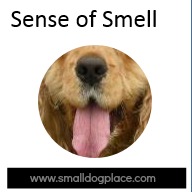Dogs Sense of Smell
The Dog Wins, Hands Down
Dogs sense of smell outranks ours by leaps and bounds. Of all the senses a dog possesses, smell reigns supreme. Blind or deaf dogs do just fine because they as with all dogs rely on their sense of smell.
Your dog’s brain may only be one-tenth the size of yours, the part that controls his sense of smell is 40 times larger than yours. A human has about 5 million scent glands compared to the dog which has anywhere from 125 to 300 million scent glands.
Dogs that have the most scent glands are those that you would expect such as hounds and working dogs such as the German shepherd.

Our fur babies make sense of their world through their amazing sense of smell. When they meet another dog, they can tell whether it is male or female, what it ate, where it has been, what it has touched, even their mood.
Dogs know just by smelling whether other dogs are ready to mate, whether they have recently given birth, whether they are nursing and even if they have had a false pregnancy. Dogs can tell much about a person as well.
People have used this remarkable sense of smell in many ways. Dogs sense of smell is used to sniff out drugs, tobacco, agricultural contraband, and bombs, locate cadavers, and find disaster victims.
We are also using dogs to detect cancer in people, predict the onset of a seizure, and even alert diabetic owners when their blood sugar rises to dangerous levels.
Dogs Sense of Smell: How it is Different from Ours

Dogs and humans smell in a fundamentally different ways. We breathe in and out through the same airway passages that lead to our lungs. If we want to get a good sniff at something, we have to inhale several times.
A dog's nose functions differently. His nostrils move independently, helping him to locate the direction of the scents. As he sniffs, air already in the nasal passages is pushed further into his nose so it does not compete with entering odors.
The exhaled air leaves through slits
on the side of his nose, and a swirl of wind created by the exhalation
helps send even more scents into the dog's nose. The dogs sense of smell is enhanced with this system by allowing them to sniff many smells at once.
A dog has
another organ for smelling that we do not have, called the vomeronasal
or Jacobson’s organ. This is a fluid-filled sac with ducts that open
into the dog’s mouth and nose.
Perhaps this system is used to detect
social cues or pheromones or hormone-like substances released by
animals. These may provide sex related information such as when a female
is ready to mate.
Humans have an aversion to malodorous things--spoiled foods and garbage, bodily discharges, pollution and exhaust, but luckily we have a way of losing the smell over time.
If we encounter an area with a bad odor and we stay there for a short while, sooner or later, we won't smell it at all.
Dogs on the other hand, continue refresh these scents in their olfactory organs allowing them to smell them over and over again.
As humans, we may never fully understand the remarkable ability of this sense in our dog, but can appreciate their uncanny ability to sense our moods.
According to Alexandra Horowitz, author of Inside of a Dog, dogs do detect our emotions. Fear is one emotion dogs are particularly able to detect.
About Janice (author and voice behind this site)
Janice Jones has lived with dogs and cats for most of her life and worked as a veterinary technician for over a decade. She has also been a small-breed dog breeder and rescue advocate and holds academic training in psychology, biology, nursing, and mental health counseling. Her work focuses on helping dog owners make informed, responsible decisions rooted in experience, education, and compassion.
When not writing, reading, or researching dog-related topics, she likes to spend time with her six Shih Tzu dogs, her husband, and her family, as well as knitting and crocheting. She is also the voice behind Miracle Shih Tzu and Smart-Knit-Crocheting
Does This Article Deserve Your Thumbs Up?
We always appreciate your support and encouragement. Your thumbs up means so much to us. Please like this article.
If you find this page or any page on Small Dog Place Helpful, or useful in anyway, I'd love it if you would click the small heart found on the bottom right of each page.
You can also share or bookmark this page -- just click on the:

Free Monthly Newsletter
Sign Up for Our Free Newsletter and get our Free Gift to You.
my E-book, The Top 10 Mistakes People Make When Choosing a Dog (and how to avoid them)

